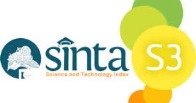RD&D Literature Review for Development of a Digital Platform for the Learning Supervision Evaluation Model (MESp)
(1) Universitas Muhammaadiyah Semarang
(2) Universitas Muhammaadiyah Semarang
(3) Universitas Muhammadiyah Lampung
(4) Universitas Negeri Islam Walisongo Semarang
(*) Corresponding Author
Abstract
This article discuss about the RD&D stages that will be used to develop the MESp digital platform. This RD&D stage is done in stages and cyclically. Each phase is evaluated, with the hope that a valid, practical and effective product will be produced, and has been tested. The development of the MESp digital platform uses the RD&D method, using the literature review method. The RD&D phases consist of: Research (Analysis, Define), Development (Design, Demonstration, Development), Diffusion (Delivery, Diffusion, Adoption). Each phase is equipped with sub-activities that must be done. Each phase evaluates PAI (Purphose, Activities, Interim Product). Users are allowed to move to the next phase, when an evaluation has been produced that can answer: the achievement of its objectives, the activities that have been done, and the temporary products produced. Users are given the freedom to add sub-activities from each phase, if that necessary and for a clear reason.
Keywords
Full Text:
PDFReferences
Akker, J.V.D & Plomp, T . 1993. Development research in curriculum: propositions and experiences. Draft paper for symposium at AERA meeting, Atlanta. University of Twente. The Nedherland.
Akker, J.V.D. 2000. Prinsciples and methods of development research. University of Twente. Proceedings of the seminar conducted at the East China Normal University, Shanghai (PR China), November 23-26, 2007
Akker, J.V.D. 2007. Curriculum Design Research dalam an introduction to educational design research. Proceedings of the seminar conducted at the East China Normal University, Shanghai (PR China), November 23-26. P. 37-52.
Akker. 1999. Principles and Method of Development Research. Dalam. van den Akker, J., Branch, R.M., Gustafson, K., Nieveen, N., & Plomp, T. (pnyt.)”. Design approaches and tools in educational and training. Dordrecht: Kluwer Academic Publisher.
Allen, M.J., & Yen, W.M. 1979. Introduction to measurement theory . Monterey, CA: Brooks Cole.
Almomen, R. , Kaufman, D. , Alotaibi, H. , Al-Rowais, N. , Albeik, M. and Albattal, S. 2016. Applying the ADDIE—Analysis, Design, Development, Implementation and Evaluation—Instructional Design Model to Continuing Professional Development for Primary Care Physicians in Saudi Arabia. International Journal of Clinical Medicine, 7, 538-546. doi: 10.4236/ijcm.2016.78059.
Battles, J.B. 2006. Proving Patient Safety by Instructional Systems Design. Quality & Safety in Health Care, 15, 25-29. http://dx.doi.org/10.1136/qshc.2005.015917
Bruce W. Tuckman . 1978. Conducting Educational Research. Harcourt Brace Jovanovich, ISBN. 0155129813, 9780155129818. https://doi.org/10.1177/001316448004000244
Carey, L. & Dick, W. 2005. The Systematic Design of Instruction. Longman; New York, NY.
Cennamo Katerine & Kalk, D. 2018. Real World Instructional Design. An Iterative Approach to Designing Learning Experiences. Edition2nd Edition. eBook Published19 December 2018. eBook ISBN9780203712207. Pub. LocationNew York. DOIhttps://doi.org/10.4324/9780203712207
Cennamo, K. & Lalk, D. 2005. Real World Instructional Design: An Iterative Approach to Designing Learning Experiences 2nd Edition. Thomson Wadsworth
Department of Health. 2015. Allied Health Professions Project: Demonstrating Competence through Continuing Professional Development [CPD].
http://webarchive.nationalarchives.gov.uk/+/www.dh.gov.uk/en/consultations/closedconsultations/DH_4071458
Faeha, A., Wahid, A, & Udaibah, W. 2019. Pengembangan bahan ajar kimia berbasis integrasi islam-sains materi minyak bumi sebagai implementasi pendidikan karakter. Journal of Educational Chemistry (1 (1), Juni 2019, 15-21). ISSN 2685-4880. DOI: 10.21580/jec.2019.1.1.3937
Hannafin, Micahel, J. & Peck, Kyle L. 1988. The Design, Development, and Evaluation of Instructional Software. New York: Macmillan Publishing Company
Pieters, J. et al. (Eds). 2019. Collaborative Curriculum Design for Sustainable Innovation and Teacher Learning. https://doi.org/10.1007/978-3-030-20062-6_2.
Maina, M. 2012. Developing a Method for the Design of Sharable Pedagogical Scenarios. In N. Alias, & S. Hashim (Eds.) Instructional Technology Research, Design and Development: Lessons from the Field (pp. 86-101). Hershey, PA: Information Science Reference. doi:10.4018/978-1-61350-198-6.ch006
Molenda, M. 2003. In search of the ellusive ADDIE model. Pervormance improvement, 42 (5), 34-36. Submitted for publication in A. Kovalchick & K. Dawson, Ed’s, Educational Technologi: An Encyclopedia. DOI:10.1002/pfi.4930420508
Roblin, N.R & MVKenney, S. 2018. Classic Design of Curriculum Innovationa: Investigation of Teacher Involvement in Research, Development, and Diffusion. e
Richey, R. C. & Klein J. D. 2007. Design and development research: Methods, strategies, and issues. Mahwah, New Jersey: Lawrence Erlbaum.
Richey, R. C. 2005. Validating instructional design and development models. In J. Michael Spector, C. Ohrazda, A. Van Schaack & D. A. Wiley (Eds) Innovations in Instructional Technology (pp. 171-185). Mahwah, NJ, USA: Lawrence Erlbaum Associates.
Richey, R.C. 1997. Research on Instructional Development. Etrad. Vol 45. No.3. 1997.pp. 91-100.ISSN 1042-1629.
Sivasailam Thiagarajan, Dorothy S. Semmel,, & Melvyn I Semmel. 1974. Intructional development for training teachers of exceptional children. Indiana: Cana University.
Smaldino, Sharon; James D. Russel; Robert Heinich; Michael Molenda. 2005. Instructional Technology and Media for Learning. New Jersey: Pearson Merrill Prentice Hall, Upper Saddle River
Sulistyani, Y & Nirwana, R.R. 2019. Pengembangan blog pembelajaran kimia berbasis contextual teaching learning. Journal of Educational Chemistry (1 (1), Juni 2019, 44-50. ISSN 2685-4880. DOI: 10.21580/jec.2019.1.1.3936
Thiagarajan, S., Semmel, D.S,, & Semmel, M.I. 1974. Intructional development for training teachers of exceptional children. Indiana: Cana University.
Winaryati, E. 2011. Pelatihan pengembangan media pembelajaran sains, melalui analisis CIRCULAR MODEL of R&D. Prosiding Seminar Nasional Penelitian, Pendidikan dan Penerapan MIPA. ISBN:978-979-99314-5-0. Fakultas MIPA, di Universitas Negeri Yogyakarta, 14 Mei.
Winaryati, E., Mardiana & Hidatyat, M.T. 2020. Conceptual Flamwork of Evaluation Model on 4 C’s- Based Learning Supervision. International Journal of Learning. 19(8), pp. 173-193. https://doi.org/10.26803/ijlter.19.8.10
Zhou, C. 2016. Handbook of research on creative problem-solving skill development in higher education. Hershey, PA: IGI Global.
Article Metrics
Abstract view : 709 timesPDF - 196 times
DOI: https://doi.org/10.26714/jps.9.2.2021.181-192
Refbacks
- There are currently no refbacks.
Copyright (c) 2021 JURNAL PENDIDIKAN SAINS (JPS)

This work is licensed under a Creative Commons Attribution 4.0 International License.
EXECUTIVE OFFICE
JURNAL PENDIDIKAN SAINS UNIVERSITAS MUHAMMADIYAH SEMARANG
DEPARTMENT OF CHEMISTRY EDUCATION
FACULTY OF MATHEMATICS AND NATURAL SCIENCES
MUHAMMADIYAH SEMARANG UNIVERSITY
Jl. Kedungmundu Raya No.18, Semarang, Jawa Tengah, Indonesia
Telp. (024)76740231, 76740231
email: jps@unimus.ac.id

This work is licensed under a Creative Commons Attribution 4.0 International License
Journal Pendidikan Saisn (JPS)
ISSN:2339-0786, e-ISSN:2502-1443
Published by: Chemistry Education, Muhammadiyah Semarang University










